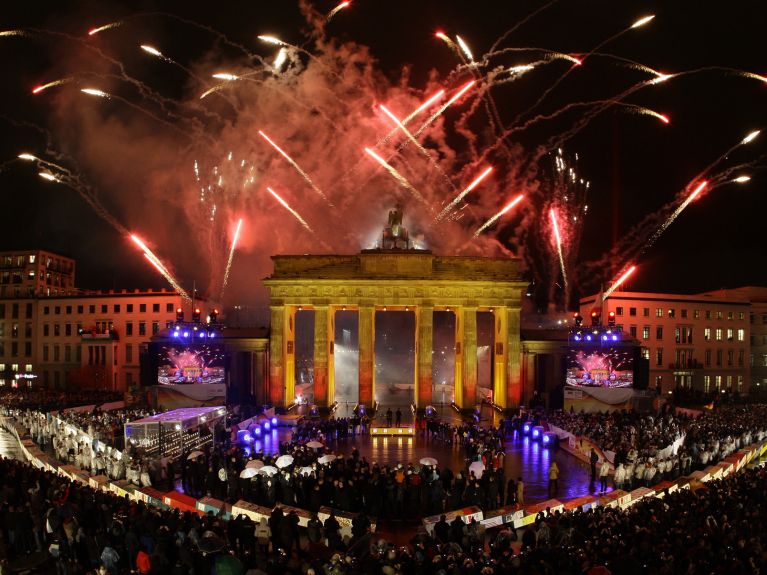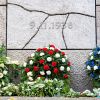The fall of the Wall and German reunification
An unprecedented historical process, the end of division and coming to terms with the past.

November 9, 1989, the day on which the Berlin Wall fell, marked the climax of a trend that was similar to a revolution and in which the citizens of the GDR played the main role. Some, because they did everything in their power to leave a state that refused to grant them the freedom to travel and who by occupying embassies abroad forced the authorities into allowing them to leave, and others because they proclaimed in no uncertain terms that they wished to stay in the GDR. However, they also demanded fundamental reforms, which the regime could not agree to without setting its downfall in motion. Given this assault on two fronts, despite massive security measures the GDR collapsed like a house of cards in the space of just a few months. This paved the way for the division of Germany to be overcome and for the country to be reunited on October 3, 1990.
At the beginning of 1989 hardly anybody in Germany, either in the west or east, had anticipated that the 40th anniversary of the GDR in the fall would also be its last, that the Berlin Wall would soon disappear, and that Germany, which was divided into two states, would be (re-) united. No one had suspected that as a result the political constellations that had dominated post-War European politics for more than forty years would dissolve. But then everything changed. All at once history, which for decades had been evolving at a snail’s pace in Europe, began trotting, before finally breaking into a wild gallop. The speed of the changes even took the breath away from those observers who were mere onlookers and not themselves directly involved in the course of events. A mere ten months after the fall of the Wall the Two Plus Four Agreement signed on September 12, 1990 paved the way for the reunification of Germany.
For a short time, German Unity, which in constitutional terms was completed on October 3, 1990 with the accession of the five new federal states “to the area of validity of the Basic Law of the Federal Republic of Germany”, triggered exuberant collective joy, borne by the certainty of being able to shoulder the challenges of the unification process. What followed, however was what Bertolt Brecht once called “the trudge across the flatlands”. The difficulties many Germans had with their newly found freedom were also a consequence of the fact that it came when hardly anybody had been expecting it and at a speed no one was used to.
The challenge “Aufbau Ost”
Following the collapse of the GDR it emerged that its average productivity was a third of that of the Federal Republic, such that instead of the expected DM 600 billion (some EUR 300 billion) profit, the Treuhandanstalt, the agency commissioned to privatize the state-owned enterprises, ultimately posted a DM 230 billion deficit. The hope of being able to finance the necessary investments in the infrastructure of the new federal states with the proceeds from the privatization of the so-called “people’s property” had been deceptive.
The cost of German Unity grew even faster than even its most pessimistic estimates had supposed. The population in the east had to bear the social burden of unity and, primarily, the population in the west the financial. The annus mirabilis of 1989/1990 was followed by a sober convergence process with a long-term perspective. Furthermore, the success stories of the “Aufbau Ost” project, which were gradually becoming visible, were still not taken adequate notice of.
One of the most spectacular results of “Aufbau Ost“ project was the renovation of inner-city residential quarters not just in cities such as Dresden, Leipzig, Chemnitz, and Halle, which in the GDR had been continually decaying. Other examples are the telecommunications facilities in the new federal states, which are among the most cutting-edge in Europe, the establishment of a competitive university structure, as well as the leading position of the solar and and environmental technology operations that have now settled there. Enormous efforts have also been channeled into infrastructure, environmental and nature protection, developing tourism and the preservation of cultural assets.
This is countered by the migration of primarily young people from east to west, which has admittedly slowed down in comparison with the first few years of unity, and the subsequent shrinking and aging of the population in the new federal states. Transfers from the west, which in 2009 totaled an estimated EUR 1.6 trillion net (minus the payments made from the east) correspond with the migration from the east. The efforts made as part of “Aufbau Ost” are an example of national solidarity, the like of which could hardly have been expected in a political atmosphere dominated by post-national discourse. Despite all the progress that has been made, in the future creating equal living conditions in the east and west will remain a primary topic in finally achieving internal unity. The Annual Report of the Federal Government on the Status of German Unity provides a regular overview of developments.
Berlin – a political center
Even in the Unification Treaty it was determined that Berlin be the capital. On June 20, 1991 the Deutsche Bundestag passed a resolution to also move the seat of government and Parliament from Bonn – since 1949 the capital of the Federal Republic – to Berlin. Since the move in 1999, Germany once again has in Berlin a pulsating political center that bears comparison with the major cities of the big European neighboring states. In addition to the newly designed Reichstag building, symbols of this are the Chancellery and the open Brandenburg Gate, which re¬presents the overcoming of the country’s division. For a while there had been fears that the government’s move to Berlin could become an expression of a new German megalomania, with which the country’s economic and political weight would upset the status quo in Europe again. These fears proved to be wrong. Rather, German Unity was to be the initial spark that led to the overcoming of the division of Europe into east and west.
As such, Germany actually played a pioneering role in the political and economic integration of the continent. In addition it gave up one of the most important instruments and symbols in the unification process, the Deutschmark, to create a European Monetary Union, the Eurozone, which would not exist without Germany. Nor, despite their being heavily involved in the unification process, have the various federal governments since 1990 ever lost sight of European integration, but have played an active role in its development, which culminated in the Lisbon process.
Ultimately, in the course of the 1990s Germany’s role in world politics also changed. The participation of German troops in international peace-keeping and stabilization missions makes this increased responsibility visible to the outside world. In domestic political discussion, however, the foreign missions are in some cases the subject of controversial discussion. In the NATO allies’ expectation that the Federal Republic of Germany take on a share of the common obligations commensurate with its size and political weight, it becomes clear in retrospect that as a divided country Germany enjoyed a political status that no longer existed when the bipolar world order came to an end. Since there is no longer a risk of confrontation between Bundeswehr troops in the west and those of the Nationale Volksarmee in the GDR, there has been continually growing international expectation for Germany to assume corresponding responsibility.
Dealing with the past
One of the most difficult chapters in German Unity includes the question of the political approach to coming to terms with the SED regime in the GDR between 1949 and 1989/1990. Apart from the fact that with regard to remembering and coming to terms with the past more and more party political positions are expressed, differences still surface. However, primarily commemorative means are being used here to address those disputes which, given the swift transfer of the disintegrating GDR in the fall and winter of 1989/1990 into the process of reunification, were broken off. Even if many of those affected do not see it this way, as a result the elite of the GDR enjoyed the protection of the federal German legal system (and the care of the welfare state), which was a deciding factor in this revolutionary-like overthrow remaining peaceful.
With the Peaceful Revolution, which formed part of the major central and eastern European freedom and civil rights movement, the Germans, who, unlike their French neighbors, had been unable to claim to have played a revolutionary role in the history of the world, did after all make a forceful mark on European revolutionary history, exactly two hundred years after the French. One can safely say that this was a decisive step along what Heinrich August Winkler called the “path to the west”, with which a reunited Germany has also relinquished its claim to a special path.


